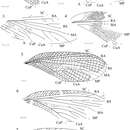ar
الأسماء في صفحات التنقل


Grylloblatta species (Grylloblattodea: Grylloblattidae), or ice-crawlers, are members of an ancient lineage that evolved during the radiation of neopterous insects (Terry & Whiting 2005). All Grylloblatta species are cryophilic, with an obligate link to stable near-freezing temperatures. Acute physiological temperature tolerance ranges from -8.5 to 10°C in an undescribed species on Mt. Ranier (Edwards 1982), and low temperature tolerance is a conserved trait in the genus (Henson 1957). Very few arthropods survive prolonged exposure to temperatures experienced on snow fields, but Grylloblatta have a foraging strategy utilizing snow-fields, where wind-blown insects and organic detritus are deposited (into the "Aeolian ecosystem") and form an energy rich resource for scavenging insects (Edwards 1987).
While five extant genera of Grylloblattidae are known, less than thirty species have been described. These species occur in northeastern Asia (Korea, Japan, China and Russia) and western North America (Canada and the western United States). A single genus, Grylloblatta, occurs in North America with eleven described species, five of which occur in California.
The species in Order Grylloblattodea are commonly known as ice crawlers or ice bugs.There are five genera and 34 species within the order.Ice crawlers are about fourteen to thirty millimeters in length and lack wings.They are nocturnal and live in high altitudes or glacial regions.Some can be found in caves.They feed on deceased arthropods, but when that source runs low they will feed on plant material. The eggs are laid in soil or moss and take about a year before the nymph emerges.It takes about five more years to reach maturity. The nymphs will molt five to nine times before becoming adults.Ice crawlers can be seen in the fossil record as far back as the Triassic.